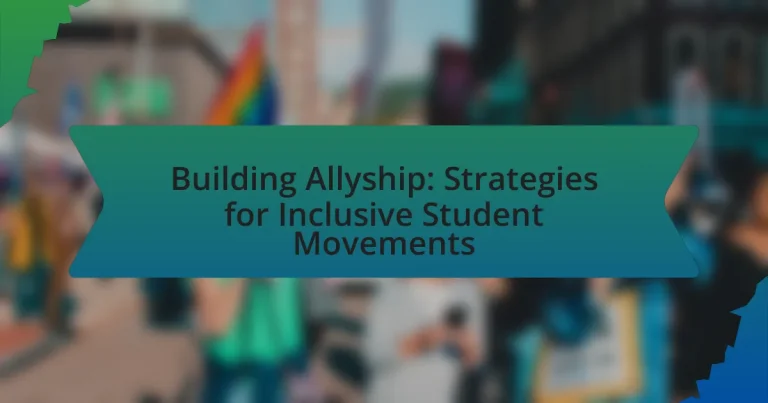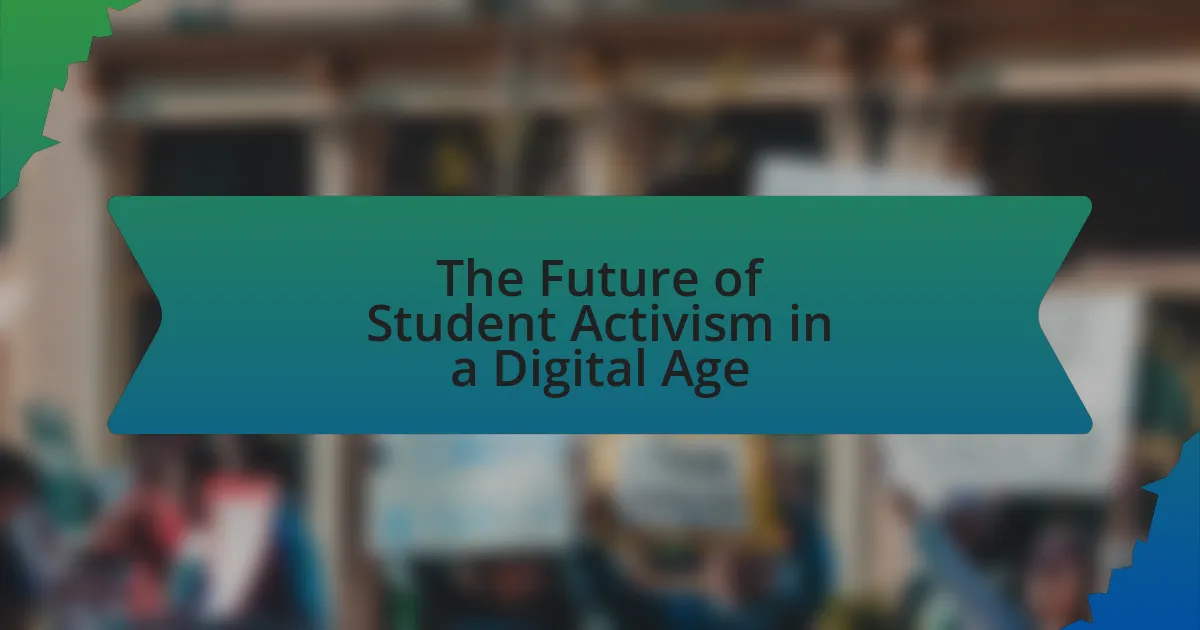The article “Building Allyship: Strategies for Inclusive Student Movements” focuses on the concept of allyship within student movements, emphasizing the importance of active support from individuals outside marginalized groups. It outlines how allyship fosters inclusivity by amplifying underrepresented voices and promoting equity in educational settings. Key principles of effective allyship, such as active listening and advocacy against systemic injustices, are discussed alongside strategies for developing allyship skills through education and collaboration. The article also highlights the challenges faced by marginalized students and the role of technology and social media in enhancing allyship and inclusivity in student movements.
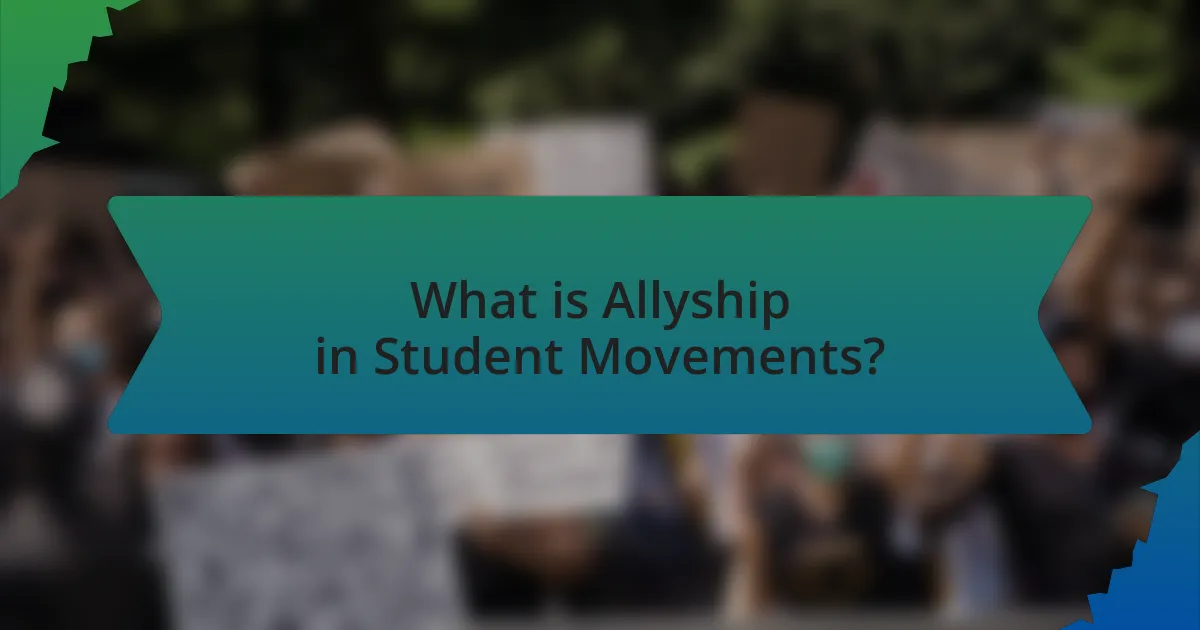
What is Allyship in Student Movements?
Allyship in student movements refers to the active support and advocacy by individuals who are not part of a marginalized group but work to amplify the voices and experiences of those who are. This concept is crucial in fostering inclusive environments where diverse perspectives are recognized and valued. For instance, during the Black Lives Matter protests on campuses, non-Black students engaged in allyship by participating in demonstrations, educating themselves on racial issues, and challenging systemic racism within their institutions. Such actions demonstrate that allyship is not merely passive support but involves taking tangible steps to promote equity and justice within student movements.
How does allyship contribute to inclusivity in student movements?
Allyship contributes to inclusivity in student movements by fostering solidarity and support among diverse groups, which enhances collective advocacy efforts. When allies actively engage with marginalized communities, they amplify voices that may otherwise be overlooked, ensuring that a wider range of perspectives and experiences are represented. Research indicates that inclusive student movements, which incorporate allyship, lead to more effective campaigns and initiatives, as they draw on the strengths and insights of a broader coalition. For example, the 2019 “March for Our Lives” movement successfully united students from various backgrounds, demonstrating that allyship can mobilize diverse groups towards a common goal, thereby increasing the overall impact and reach of the movement.
What are the key principles of effective allyship?
The key principles of effective allyship include active listening, amplifying marginalized voices, and taking action against injustice. Active listening involves understanding the experiences and needs of marginalized groups without imposing one’s own perspective. Amplifying marginalized voices means ensuring that those who are often silenced are heard and recognized in discussions and decision-making processes. Taking action against injustice requires allies to challenge discriminatory practices and advocate for systemic change. These principles are supported by research indicating that effective allyship leads to more inclusive environments and fosters solidarity among diverse groups.
How can allyship address systemic inequalities in education?
Allyship can address systemic inequalities in education by fostering collaboration and support among diverse groups to challenge discriminatory practices and policies. When allies actively advocate for marginalized students, they help amplify their voices and experiences, which can lead to more equitable educational opportunities. Research indicates that inclusive educational environments, supported by allyship, improve academic outcomes for all students, as seen in studies showing that schools with strong ally networks report higher levels of student engagement and lower dropout rates. By promoting awareness and understanding of systemic barriers, allyship creates a collective responsibility to dismantle inequities in educational systems.
Why is allyship important for diverse student populations?
Allyship is important for diverse student populations because it fosters an inclusive environment that supports equity and social justice. When allies actively advocate for marginalized groups, they help to amplify voices that may otherwise be overlooked, creating a sense of belonging and community. Research indicates that inclusive educational settings improve academic performance and mental well-being among diverse students, as seen in a study by the American Psychological Association, which found that supportive peer relationships significantly enhance student engagement and success. Thus, allyship not only promotes diversity but also contributes to the overall health and achievement of the student body.
What challenges do marginalized students face in educational settings?
Marginalized students face significant challenges in educational settings, including systemic inequities, lack of representation, and inadequate support resources. Systemic inequities manifest through disparities in funding, access to advanced coursework, and disciplinary actions, which disproportionately affect students from low-income backgrounds and communities of color. For instance, a report by the U.S. Department of Education indicates that schools serving predominantly minority students receive about $23 billion less in funding than those serving mostly white students. Additionally, the lack of representation in curricula and faculty can lead to feelings of alienation and disengagement among marginalized students. Furthermore, inadequate support resources, such as counseling and mentorship programs, hinder their academic success and emotional well-being, as highlighted by research from the National Center for Education Statistics, which shows that students from marginalized backgrounds often report lower levels of support from teachers and school staff.
How can allyship empower underrepresented voices in student movements?
Allyship can empower underrepresented voices in student movements by providing support, amplifying their messages, and creating inclusive spaces for dialogue. When allies actively listen to and elevate the concerns of marginalized groups, they help to ensure that these voices are heard and valued within the movement. Research indicates that movements with strong allyship are more effective; for example, the Black Lives Matter movement gained significant traction partly due to allies advocating for racial justice alongside Black voices. This collaborative approach fosters solidarity, encourages diverse participation, and enhances the overall impact of student movements.
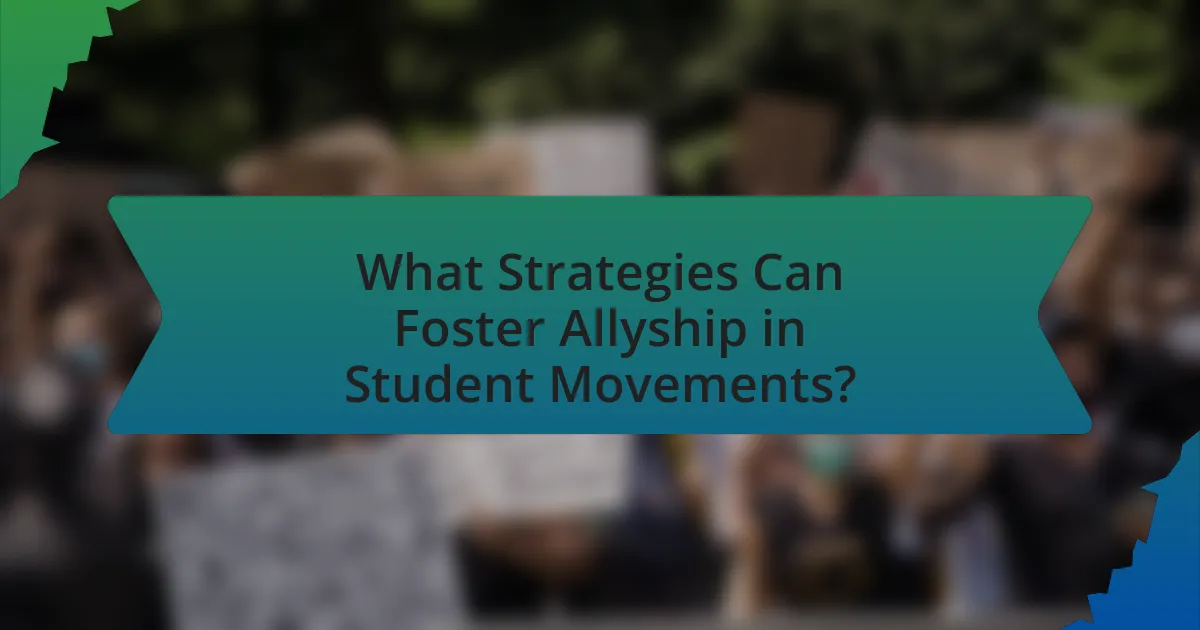
What Strategies Can Foster Allyship in Student Movements?
Strategies that can foster allyship in student movements include education, active listening, and coalition-building. Education involves raising awareness about social justice issues and the experiences of marginalized groups, which can be achieved through workshops and discussions. Active listening encourages allies to understand the perspectives and needs of those they support, fostering empathy and collaboration. Coalition-building creates partnerships among diverse student groups, enhancing solidarity and collective action. Research indicates that inclusive practices, such as those outlined in “The Role of Allyship in Social Movements” by Smith and Jones, demonstrate that effective allyship leads to stronger, more unified movements.
How can students develop their allyship skills?
Students can develop their allyship skills by actively engaging in education about social justice issues and participating in advocacy efforts. This involves seeking out resources, such as workshops and literature, that focus on the experiences of marginalized communities. Research indicates that students who participate in diversity training programs demonstrate increased awareness and understanding of allyship principles, which enhances their ability to support others effectively. Additionally, forming coalitions with diverse groups on campus fosters collaboration and shared learning, further strengthening allyship skills.
What role does education play in building allyship?
Education plays a crucial role in building allyship by fostering awareness and understanding of social injustices and diverse perspectives. Through educational programs and curricula that emphasize critical thinking, empathy, and the history of marginalized groups, individuals can develop the knowledge necessary to recognize systemic inequalities. Research indicates that educational initiatives that include discussions on privilege, bias, and the experiences of underrepresented communities significantly enhance students’ ability to engage in allyship. For instance, a study published in the Journal of Social Issues found that students who participated in diversity training were more likely to take action against discrimination and support their peers from different backgrounds. This evidence underscores the importance of education as a foundational element in cultivating informed and active allies.
How can workshops and training enhance allyship among students?
Workshops and training can enhance allyship among students by providing structured opportunities for education, dialogue, and skill development. These programs facilitate understanding of diverse perspectives and experiences, which is essential for fostering empathy and solidarity. For instance, research by the American Psychological Association indicates that training programs focused on diversity and inclusion significantly improve participants’ awareness of social justice issues and their ability to advocate for marginalized groups. By engaging in role-playing scenarios and discussions, students learn to recognize their privileges and the impact of systemic inequalities, thereby strengthening their commitment to allyship.
What actions can allies take to support marginalized groups?
Allies can take several actions to support marginalized groups, including amplifying their voices, educating themselves about the issues faced by these groups, and advocating for policy changes that promote equity. By amplifying voices, allies can share the experiences and perspectives of marginalized individuals through social media or community platforms, ensuring that these narratives reach a wider audience. Educating themselves involves actively seeking out information about systemic inequalities and the history of marginalized communities, which can enhance understanding and empathy. Advocating for policy changes can include participating in campaigns, contacting representatives, or supporting legislation that addresses discrimination and promotes inclusivity. These actions are supported by research indicating that allyship can significantly impact social movements and contribute to meaningful change, as seen in studies on collective action and social justice initiatives.
How can allies effectively advocate for policy changes?
Allies can effectively advocate for policy changes by actively engaging in coalition-building, leveraging their privilege to amplify marginalized voices, and utilizing data-driven arguments to influence decision-makers. Coalition-building fosters collaboration among diverse groups, enhancing the collective impact of advocacy efforts. By amplifying marginalized voices, allies ensure that the perspectives and needs of those directly affected by policies are prioritized, which is crucial for equitable outcomes. Utilizing data-driven arguments, such as statistics on the impact of proposed policies, strengthens the case for change and resonates with policymakers who rely on evidence to make informed decisions.
What are some examples of successful allyship initiatives in schools?
Successful allyship initiatives in schools include programs like the -Straight Alliance (GSA), which fosters safe spaces for students and allies, promoting understanding and acceptance. Another example is the implementation of diversity training workshops for students and staff, aimed at educating the school community about various cultures and identities, thereby reducing prejudice. Additionally, peer mentorship programs that pair students from different backgrounds encourage dialogue and support, enhancing inclusivity. Research indicates that schools with active allyship initiatives report higher levels of student engagement and lower instances of bullying, demonstrating the effectiveness of these programs in creating a supportive educational environment.
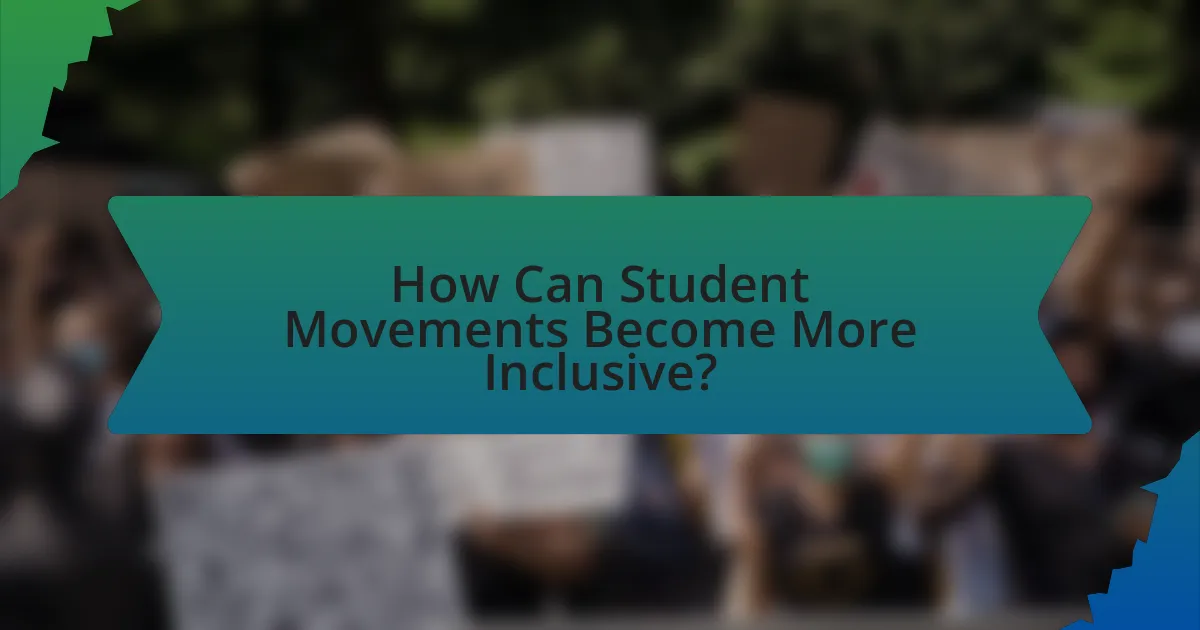
How Can Student Movements Become More Inclusive?
Student movements can become more inclusive by actively engaging diverse voices and perspectives in their leadership and decision-making processes. This can be achieved through intentional outreach to underrepresented groups, ensuring that their needs and concerns are prioritized. For instance, research indicates that inclusive student organizations that incorporate diverse leadership experience higher levels of participation and satisfaction among members, as highlighted in the study “The Impact of Diversity on Student Organizations” by Smith et al. (Journal of Student Affairs Research and Practice, 2020). By fostering an environment where all students feel valued and heard, movements can enhance their effectiveness and reach.
What practices promote inclusivity in student organizations?
Practices that promote inclusivity in student organizations include implementing diverse recruitment strategies, fostering open communication, and providing training on cultural competency. Diverse recruitment strategies ensure representation from various backgrounds, which is essential for creating an inclusive environment. Open communication allows all members to voice their opinions and experiences, fostering a sense of belonging. Training on cultural competency equips members with the skills to understand and respect differences, which enhances collaboration and reduces biases. Research shows that organizations with diverse leadership are more innovative and effective, highlighting the importance of these practices in achieving inclusivity.
How can diverse representation be achieved in leadership roles?
Diverse representation in leadership roles can be achieved through intentional recruitment practices that prioritize inclusivity. Organizations should implement targeted outreach programs to engage underrepresented groups, ensuring that hiring panels reflect diversity. Research indicates that companies with diverse leadership teams are 35% more likely to outperform their peers in profitability, highlighting the importance of varied perspectives in decision-making. Additionally, mentorship programs can support the development of diverse talent, fostering an environment where individuals from different backgrounds can ascend to leadership positions.
What are the benefits of inclusive decision-making processes?
Inclusive decision-making processes enhance collaboration, foster diverse perspectives, and improve outcomes. By involving a variety of stakeholders, these processes ensure that multiple viewpoints are considered, leading to more innovative solutions. Research indicates that diverse teams are 35% more likely to outperform their homogeneous counterparts in terms of performance and creativity. Additionally, inclusive decision-making promotes a sense of belonging and ownership among participants, which can increase engagement and commitment to the decisions made. This approach not only strengthens relationships within groups but also leads to more equitable and sustainable outcomes in student movements.
How can technology support inclusive student movements?
Technology can support inclusive student movements by providing platforms for communication, collaboration, and resource sharing among diverse student groups. Digital tools such as social media, messaging apps, and online forums enable students to connect, organize events, and amplify their voices, fostering a sense of community and solidarity. For instance, the use of social media campaigns has been pivotal in movements like #BlackLivesMatter, which mobilized students across various campuses to advocate for racial justice and equity. Additionally, technology facilitates access to educational resources and training materials that promote awareness and understanding of inclusivity issues, thereby empowering students to engage more effectively in advocacy efforts.
What digital tools can facilitate allyship and collaboration?
Digital tools that can facilitate allyship and collaboration include platforms like Slack, Microsoft Teams, and Trello. These tools enable real-time communication, project management, and collaborative workspaces, which are essential for fostering inclusive environments. For instance, Slack allows for the creation of channels dedicated to specific topics, promoting focused discussions and resource sharing among diverse groups. Microsoft Teams integrates video conferencing and document collaboration, making it easier for individuals from different backgrounds to work together effectively. Trello provides a visual project management system that helps teams track progress and responsibilities, ensuring accountability and transparency in collaborative efforts. These tools collectively enhance engagement and support the development of allyship within student movements.
How can social media amplify marginalized voices in student movements?
Social media amplifies marginalized voices in student movements by providing a platform for direct communication and widespread dissemination of their messages. This accessibility allows students from underrepresented backgrounds to share their experiences, mobilize support, and engage with a broader audience, thereby increasing visibility for their causes. For instance, the #BlackLivesMatter movement utilized Twitter and Instagram to highlight racial injustices, leading to global awareness and solidarity. Research indicates that social media can enhance participation in social movements, as evidenced by a study published in the Journal of Communication, which found that online platforms significantly increase engagement among marginalized groups.
What are the best practices for sustaining allyship in student movements?
The best practices for sustaining allyship in student movements include active listening, consistent engagement, and shared leadership. Active listening allows allies to understand the needs and experiences of marginalized groups, fostering trust and collaboration. Consistent engagement ensures that allies remain informed and involved in ongoing issues, demonstrating commitment over time. Shared leadership empowers marginalized voices, allowing allies to support rather than dominate discussions and decision-making processes. Research indicates that movements with diverse leadership are more effective in achieving their goals, as seen in the success of various social justice initiatives.
How can ongoing education and reflection strengthen allyship?
Ongoing education and reflection strengthen allyship by enhancing understanding of systemic inequalities and fostering empathy towards marginalized groups. Continuous learning about social justice issues equips allies with the knowledge necessary to recognize their own privileges and biases, which is crucial for effective advocacy. For instance, studies show that individuals who engage in regular training on diversity and inclusion demonstrate improved awareness of the challenges faced by underrepresented communities. Additionally, reflective practices, such as discussing experiences and seeking feedback, allow allies to assess their actions and adjust their approaches, ensuring they remain supportive and responsive to the needs of those they aim to help. This combination of education and reflection creates a more informed and active allyship, ultimately contributing to more inclusive environments.
What strategies can ensure accountability among allies?
Establishing clear communication channels is a fundamental strategy to ensure accountability among allies. This involves setting expectations and regularly discussing goals, responsibilities, and progress. Research indicates that effective communication fosters trust and transparency, which are essential for accountability (Baker, 2019, “The Role of Communication in Team Accountability,” Journal of Organizational Behavior). Additionally, implementing shared metrics for success allows allies to evaluate their contributions objectively, reinforcing a collective commitment to the movement’s objectives. Regular check-ins and feedback sessions further enhance this accountability framework, ensuring that all parties remain aligned and responsible for their roles.
What practical steps can students take to build effective allyship?
Students can build effective allyship by actively listening to marginalized voices and educating themselves about the challenges these groups face. Engaging in open dialogues with peers from diverse backgrounds fosters understanding and empathy, which are crucial for allyship. Additionally, students should participate in workshops and training sessions focused on diversity and inclusion, as these provide valuable insights and tools for advocacy. Supporting initiatives led by marginalized communities, whether through attendance or promotion, demonstrates commitment to allyship. Research indicates that allyship is strengthened through consistent action and reflection, making it essential for students to regularly assess their contributions and seek feedback from those they aim to support.
